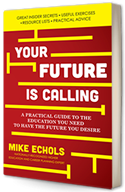Upward social mobility in America is definitely harder but it is not dead. What you need to do is get an education to have the best chance at a better life. Here is the evidence that should motivate you to get that education.  Source: New York Times An American child born into the lowest 20 percent income level has a less than a 1 in 20 chance of making it to the top, as Mr. Obama pointed out. But one born in the top 20 percent has a 2 in 3 chance of staying there. Source: New York Times: Further, more people express uncertainty in chance to achieve the American dream: a majority believe that the American Dream is becoming markedly more elusive. More than six in ten workers worry that they will lose their jobs because of the economy. Less than half of Americans expect to move up in their economic class over the next few years.
Source: New York Times An American child born into the lowest 20 percent income level has a less than a 1 in 20 chance of making it to the top, as Mr. Obama pointed out. But one born in the top 20 percent has a 2 in 3 chance of staying there. Source: New York Times: Further, more people express uncertainty in chance to achieve the American dream: a majority believe that the American Dream is becoming markedly more elusive. More than six in ten workers worry that they will lose their jobs because of the economy. Less than half of Americans expect to move up in their economic class over the next few years.
While the hope of upward mobility is getting pummeled by the bickering politicians in Washington, the reality is that social mobility is still possible. What it requires is for you, the individual, to take action rather than waiting for policy makers to do their job. Getting an education is the most important investment you can make in yourself.
Source: Federal Reserve Board of San Francisco: “Economic mobility, or the ability of individuals to move up or down the income distribution, is a fundamental value in the United States, one that defines the American dream. Absolute mobility (adults who have higher income than their parents did) is 67%. Absolute mobility is greatest for those in the lowest quintile. 83% of those in the lowest birth quintile had larger adult incomes than their parents did. These results show that most Americans are able to achieve the American Dream in the sense that their income is greater than that of their parents.”
But the most important information about the impact of education on social mobility is deeper in the Federal Reserve report under the heading relative mobility. “Relative Mobility is the extent to which individuals can change rank in the income distribution relative to their parents. Here, only 5% of children born into the bottom quintile (the one in twenty the president refers to in the New York Times BUZZ Today article) who didn’t graduate from college end up in the top quintile. By contrast, 30% of bottom-quintile children who graduate rise all the way to the top quintile. But only 7% of those born to parents in the bottom quintile get a college degree.”
The implications are clear. Without a college degree moving out of the bottom quintile is nearly impossible. With a degree, a relatively large percentage (30%) who graduated actually move from the bottom to the top quintile of the income distribution. Just to put this in perspective, 33% of those born in the top quintile actually fall down out of that quintile. Social mobility is alive both moving up and moving down.
To move up it is clear that a college education is key. Which major you select, where you go to school and how you reduce your costs are all important. See Your Future is Calling for details on how to manage these.
Just to show that it is actually happening, here is data from California tax records that show how tens of thousands of Californians actually moved up by getting an associates degree in the California Community College system where resident tuition is less than $1,200 per semester and an associates degree costs less than $6,000 in total tuition.
Here is why selecting your major is so important and what is possible when you make good choices.
Source: California Community College office of the Chancellor
Income (annual)
Associate graduate 2 years before 2 years after 5 years after
Forensics and Investigation $12,501 $24,313 $43,806
Home Services $17,115 $27,160 $36,531
Police academy $23,972 $54,154 $70,520
Cardiovascular Tech $12,298 $62,211 $71,841
Physicians Assistant $15,163 $70,068 $95,727
Dental Hygienist $16,130 $63,750 $62,507
Pharmacy Tech $11,838 $32,592 $39,160
Registered Nurse $17,072 $67,618 $78,801
Physics, general $10,969 $27,308 $56,618
Automotive Tech $12,746 $35,675 $41,023
Biomedical Tech $12,695 $44,562 $55,673
The comparison of the income in the left column with the income in the right column is strong evidence of significant upward mobility as a result of very affordable education. The left column (where they started) is every bit as important to this conversation as the salaries in the right column. But there are no guarantees as in “Is College Worth It?” The following data shows the importance of making wise choices when it comes to selecting you major and the career that follows.
Journalism $14,664 $25,672 $17,347
Cosmetology $14,970 $20,354 $18,662
Applied Photography $16,561 $16,270 $22,011
Child Development Admin $14,308 $20,489 $17,573
Film Production $ 7,800 $16,032 $10,931
These graduates started in the same place as those in the top half of the table but they ended up with very different results. The conclusion is that upward mobility from a low starting point is highly possible with the right education. But it’s not automatic. There are no guarantees. You must be informed and select your career and major wisely.
